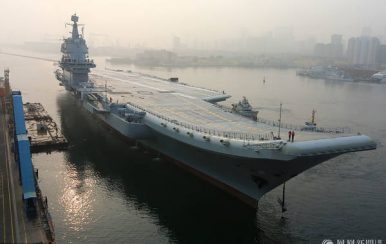By Franz-Stefan Gady
 The People’s Liberation Army Navy’s (PLA Navy) first domestically designed and built aircraft carrier, the Type 001A Shandong (CV-17), began its maiden sea trial early Sunday morning, Chinese state media reported. The yet-to-be-christened warship set out at 7am local time from a dock at the Dalian Shipbuilding Industry Company (DSIC) shipyard in China’s Liaoning Province, according to local media reports. The first round of sea trials is expected to primarily test the reliability of the carrier’s power and propulsion systems. Furthermore, “sea trials will test the carrier’s overall seaworthiness including its speed, maneuverability, and equipment such as radar and communications systems, as well as safety features,” I noted in April.
The People’s Liberation Army Navy’s (PLA Navy) first domestically designed and built aircraft carrier, the Type 001A Shandong (CV-17), began its maiden sea trial early Sunday morning, Chinese state media reported. The yet-to-be-christened warship set out at 7am local time from a dock at the Dalian Shipbuilding Industry Company (DSIC) shipyard in China’s Liaoning Province, according to local media reports. The first round of sea trials is expected to primarily test the reliability of the carrier’s power and propulsion systems. Furthermore, “sea trials will test the carrier’s overall seaworthiness including its speed, maneuverability, and equipment such as radar and communications systems, as well as safety features,” I noted in April.
The sea trials are going to take place in the northeastern part of the Bohai Sea, the innermost gulf of the Yellow Sea and Korea Bay. The Liaoning Maritime Safety Administration has declared a restricted area off the Dalian coast from Sunday to noon on Friday May 18. Last month, the local maritime authority announced that it had requested three areas in the northeastern Bohai and Yellow Seas to be cordoned off for PLA Navy activities for eight days raising expectations that the Type 001A was going to set out for its maiden voyage that month.
There was also some speculation that carrier’s sea trials would coincide with the annual Spring Festival or Chinese New Year in mid-February.
The Shandong’s sea trials mark a major milestone in China’s blue water navy ambitions and its quest to built a maritime force capable of operating globally. As I wrote earlier this month, while the Shandong is China’s first domestically built flattop, it is heavily influenced by Soviet carrier designs:
The 65,ooo-ton Type 001A carrier was launched at the DSIC shipyard in April 2017. The warship is an improved variant of the PLAN’s only operational aircraft carrier, the 60,000-ton Type 001 Liaoning — a retrofitted Soviet-era Admiral Kuznetsov-class multi-role aircraft carrier. (The Liaoning and its escort ships entered Taiwan’s air defense identification zone [in March] during a naval training exercise.)
The Shandong has been fitted with a so-called ski-jump assisted Short Take-Off But Arrested Recovery (STOBAR) launch system also installed aboard the Liaoning. STOBAR-launched aircraft have a more limited operational range and carry lighter payloads than fighter jets launched from so-called Catapult-Assisted Take-Off But Arrested Recovery (CATOBAR) systems used on U.S. Navy carriers. (STOBAR systems put a lot of strain on the airframe of fighter jets during take-off.)
The Shandong will be able to carry up to 24 Shenyang J-15 multirole fighter jets, a variant of the fourth-generation Sukhoi Su-33 twin-engines air superiority fighter, as well as around ten rotary wing aircraft including Changshe Z-18, Ka-31, or Harbin Z-9 helicopters.
Unlike the Liaoning, which primarily serves as test platforms for Chinese carrier-based naval aviation and technology demonstrator, the Shandong is expected to be operationally deployed and serve in the PLA Navy’s North Sea Fleet or East Sea Fleet after its commissioning.
The full set of sea trials of the Shandong is expected to take six to 12 months. The PLA Navy has not officially announced a commissioning date yet for the carrier, although there is some speculation that it will take place in the last quarter of 2018.
China reportedly began construction of a third aircraft carrier, designated Type 002, at a Shanghai shipyard last year. The new carrier is expected to be fitted with a conventionally-powered catapult assisted take-off but arrested recovery (CATOBAR) aircraft launch system similar to the U.S. Navy’s electromagnetic aircraft launch system (EMALS) installed on the Gerald R. Ford-class supercarrier. The Chinese-designed CATOBAR system would substantially boost the PLA Navy carrier force’s naval air power.
“CATOBAR aircraft launch systems put less strain on the airframe of planes during takeoff reducing maintenance cost in the long run and also allows carrier-based aircraft to carry a heavier weapons payload,” I explained previously. “Furthermore, CATOBAR launch systems increase the sortie rates of carrier air wings by allowing a faster landing and takeoff rate.”
No comments:
Post a Comment